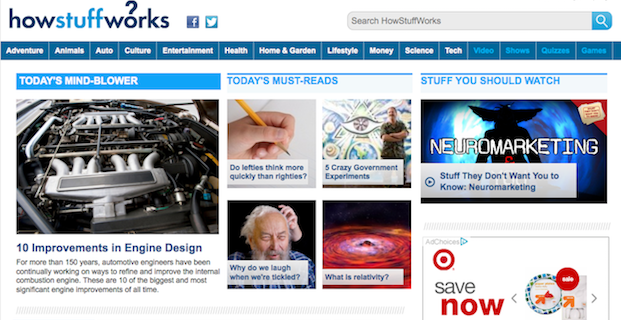by Mark Bloom | Jun 20, 2014 | Small Business Advice
Why Your Customers Do Business with You

Every business faces competition. In America, competition is a given. It’s part of the invisible hand that moves markets. You likely don’t appreciate it, however, while your business is trying to make inroads into your competitors’ market share.
But competition is healthy. It can bring out the best in all of us, even if we lose the race, since the best lessons come not from victory but from defeat. And you can quote me on that.
What Do You Offer?
To get more business, you must have a strategy or plan or advantage over your rivals. Whatever it is — a superior product, 24/7/365 personalized customer service or simply that you have the best location — it is your unique value proposition. This is what sets you apart from your peers. It’s why you deserve a bigger share of the marketplace.
If you don’t have a unique value proposition, then you are no different from the shop down the street or the next service listed in the phone book. Without a unique value proposition, there’s no reason for potential customers to choose your business over another. So rethink your business plan and make sure you have a specific answer to that age-old question: Why should I buy from you?
How to Use Your Unique Value Proposition
 You’ve done all the work and figured out your unique value proposition. You now know what sets your business apart. You have figured out why your business is so much better than your competition. So why doesn’t the world beat a path to your door? What’s holding you back?
You’ve done all the work and figured out your unique value proposition. You now know what sets your business apart. You have figured out why your business is so much better than your competition. So why doesn’t the world beat a path to your door? What’s holding you back?
The most obvious problem is that no one else knows what your unique value proposition is! Have you told anyone besides your spouse, your mom, and your employees? That’s right, you have to communicate your value to your target market, the very people who make the decisions to buy your products or services.
If you advertise, make sure your unique value proposition is front and center, clear and simple. Your potential customers want to know. You don’t have to persuade them to buy from you; you simply have to tell them why it’s in their best interest.
Ray Access Can Help
Ray Access is a content marketing firm. We provide content for your website, turning your site from a passive brochure into a attractive announcement. Your website should draw an audience and then turn those visitors into customers. That’s the purpose of a website. That’s the value of an effective website.
And that’s where Ray Access can help. We’ll turn your website into a marketing engine. We’ll expose your unique value proposition on every page. With words and pictures, we’ll give your visitors a reason to buy from you.
The Ray Access Value Proposition
 So what’s our unique value proposition? You get two for the price of one. Ray Access is an everyday, all-the-time, true-blue BOGO. Buy one, get one free. There are other good writers out there and some pretty talented editors too. But when you hire Ray Access, you get both — every time.
So what’s our unique value proposition? You get two for the price of one. Ray Access is an everyday, all-the-time, true-blue BOGO. Buy one, get one free. There are other good writers out there and some pretty talented editors too. But when you hire Ray Access, you get both — every time.
No piece of writing leaves our hands until both Mark Bloom and Linda Ray have touched it. We each read and edit every blog, press release and web page. We bring years of professional journalism, book editing, magazine publishing, technical writing and research expertise to every job.
Contact us to discover how we can help you. You’ll quickly understand that Ray Access is more than a writing service. We provide content that will help your business grow.
Ray Access is a content marketing firm that delivers targeted words to empower your business. Contact us about your specific project to receive a quote or discuss your needs. We write website copy, blog posts, e-newsletters and more. Everything we do is thoroughly researched, professionally edited and guaranteed original.
by Mark Bloom | Jun 4, 2014 | Writing
Choosing the Right Tone and Language

Targeting your website — or any communication from your company to your customers — is a matter of building a relationship. To make that connection, you have to use language that’s familiar to those you’re trying to reach. For example, it may be all right to use slang when you’re writing to attract teenagers, but not when your audience is composed of CEOs.
The language and style you employ in your writing should be geared to the audience — the customers — you want to attract. Speak their language, and you stand a better chance of connecting with them. If you build a relationship with your target demographic, whatever it is, you’ll stand a better chance of selling your products or services to them.
How Ray Access Does It
When we take on new clients, we always pose the same set of questions. One of them includes who their customers are: the general public, doctor’s offices, or women aged 35–55. Your target audience defines how we will write both your website and your blog posts.
We like to meet our clients in person, to get a feel for who they are and to listen to them when they speak. When we start writing for them, we set aside time for the client to approve the style and language, as well as the content, of our initial draft. We expect some back-and-forth of the copy until our client approves.
One time, a client removed all the contractions we’d put into the copy. Another client changed specific words. It’s exactly the kind of feedback we want at this stage. Once we know our client’s preferences, in addition to the target audience, we know we can deliver content that will appeal to both our client and the intended audience.
How You Can Do It
 If you want to create your own content — for your website, your blog, or your brochure — you must know who you want to read what you write. Who is your audience? Who will buy your products or services? Write to them in a friendly, engaging way.
If you want to create your own content — for your website, your blog, or your brochure — you must know who you want to read what you write. Who is your audience? Who will buy your products or services? Write to them in a friendly, engaging way.
Whether you need to be formal or casual depends on both your personality and your audience. Study your competitor’s websites. See what type of language they use. Are they doing a good job connecting to their audience? How can you be different enough to stand out? These simple questions can point you in the right direction.
When You Can’t Do It
If you get stuck, or if you don’t know where to start despite the advice in this article, contact Ray Access for help. We are pros when it comes to writing your website, your blog posts, your brochure or whatever you need. We’ve written hundreds of blog posts for a diverse set of clients. We’ve written websites as small as six pages and as large as over a hundred pages. Since we are a partnership, we write and edit everything that we send to you, so you can be sure it’s clean copy free of errors.
Let us be your voice to your customers!
Ray Access is a content marketing firm that delivers targeted words to empower your business. Contact us about your specific project to receive a quote or discuss your needs. We write website copy, blog posts, e-newsletters and more. Everything we do is thoroughly researched, professionally edited and guaranteed original.
by Mark Bloom | May 5, 2014 | Website Content
Your Website Content Makes a Big Difference

More and more of our clients have been asking for website content. There’s good reason to upgrade your website content, especially if your website isn’t working for you. Our two unofficial mottos are:
- If your website isn’t making you money, it’s costing you money.
- If you’re ignoring your website, it’s likely ignoring you.
These aren’t just clever phrases; they underline our business philosophy that every website is a potential marketing engine. If you aren’t optimizing your website for your company, you’re losing ground to your competition. The trends are clear: the Internet is the new yellow pages. If your listing doesn’t appear, you are losing business.
First Step: Fresh Content
The first thing we do for our clients is to update their websites to make sure the content addresses their target audience: their existing and potential customers. It has to welcome visitors, introduce a business and answer their questions.
We often recommend an active blog, because business blogging is an excellent way to attract new customers and answer more questions in a more in-depth manner. That makes the website more useful, and useful content online often is shared. If your visitors are sharing your content, that’s better than advertising.
Landing Pages Work
 The next logical step, once the website content is working to attract new visitors, is to turn those visitors into customers. That’s the goal of landing pages.
The next logical step, once the website content is working to attract new visitors, is to turn those visitors into customers. That’s the goal of landing pages.
A landing page is a special page constructed on your website that you direct people to when you want them to learn more about your products or services. The classic example of a landing page is the website page where you send web users who click on your ad somewhere else (e.g., on a social media site). By clicking the ad, they have already demonstrated interest in your company, so you want them to land on a useful, informative and active page.
In this case, your landing page must explain your competitive advantage. You have to sell your company. You have to persuade the visitor to buy your products or services. Normally, your website should not be an avenue to push your products or services onto your visitors. That drives people away. But a landing page is different. On the landing page, you want to give them options and a way to contact you or make a purchase.
Put Theory into Practice
Now that you understand how your website is supposed to operate to generate business and convert visitors into customers, get to it! Contact us for a website assessment, and we’ll give you our honest, objective feedback regarding your website’s effectiveness, whether you hire us or not. What have you got to lose, except inertia?
Ray Access is a content marketing firm that delivers targeted words to empower your business. Contact us about your specific project to receive a quote or discuss your needs. We write website copy, blog posts, e-newsletters and more. Everything we do is thoroughly researched, professionally edited and guaranteed original.
by Mark Bloom | Apr 15, 2014 | Website Content
Content Marketing Effectively Converts Leads
Here in Asheville, North Carolina, we talk about content marketing a lot. Content marketing is, in essence, turning your website into a marketing engine by supplying useful information that attracts an audience. It works, and we have documented proof. We’ve also written about quality content before.
But it’s more than that. In case you’ve missed it, the Internet is replacing the Yellow Pages as the primary way consumers are looking for your products or services. It’s a sign of the times, just like other things that have disappeared, like rotary telephones, landlines and typewriters. So if you are ignoring your website, as our motto says, your website is ignoring you. That’s not a smart business decision.

So whether you hire us or not, we urge you to adopt content marketing strategies. But even if you are doing everything you can to put content marketing to work on your business website, the next question is: Will just doing this simple thing actually convert the visitors you attract to your website into paying customers?
Content Marketing Is User-Centric
 The answer, of course, is yes. Content marketing, if properly done, can persuade your website visitors to become clients. Content marketing employs a user-centric approach, to use a term from the 1990s. “User-centric” means that you design your website with your visitors in mind. Make their experience everything they could hope for, and they’ll reward you with their business.
The answer, of course, is yes. Content marketing, if properly done, can persuade your website visitors to become clients. Content marketing employs a user-centric approach, to use a term from the 1990s. “User-centric” means that you design your website with your visitors in mind. Make their experience everything they could hope for, and they’ll reward you with their business.
You must make your website easy to navigate. Make your content easy to understand. Answer your visitors’ obvious questions and provide your contact information on every page. Provide helpful tips and advice about your industry, products or services. To sum up: make your website valuable to your community of users. “User-centric.”
When Your Customers Have Landed

Even if you do all this and your website is attracting a lot of traffic, you still must sell your company’s products or services. Knowing where and when and how to do this is a science, but it’s not rocket science. One tip is to construct effective “landing pages.”
A landing page is where visitors interested in a specific topic, product or service arrive on your website through a search engine or internal link. Landing pages must answer the questions about specific topics and effectively explain how your company can solve the associated problems. It’s not a pushy sales page. It’s not an advertisement. It’s a question-and-answer session, where your company has the best answer.
Content Marketing Has a Positive ROI
 A landing page can be a blog post or a website page. It doesn’t matter, as long as it satisfies the above criteria. In fact, this very blog post can act as both an informative article and a landing page, since it targets businesses that need to learn about converting website visitors or creating better content on their websites — since Ray Access can do this for you, at a reasonable cost and with a proven return on investment (ROI).
A landing page can be a blog post or a website page. It doesn’t matter, as long as it satisfies the above criteria. In fact, this very blog post can act as both an informative article and a landing page, since it targets businesses that need to learn about converting website visitors or creating better content on their websites — since Ray Access can do this for you, at a reasonable cost and with a proven return on investment (ROI).
Get a free estimate. We also offer a website analysis service that can provide an objective assessment of your website.
Ray Access is a content marketing firm that delivers targeted words to empower your business. Contact us about your specific project to receive a quote or discuss your needs. We write website copy, blog posts, e-newsletters and more. Everything we do is thoroughly researched, professionally edited and guaranteed original.
by Mark Bloom | Mar 30, 2014 | Website Content
5 Tips That Can Help Your Site Right Now
Websites matter. A good website draws people in and coverts them into customers. The question everyone asks us is: “What makes a website good?”
So let us answer this question for all of you at once so you can improve your website. We’ve written — and rewritten — many websites. You can see several examples of our work in our Portfolio. We believe that if your website isn’t making you money, then it’s costing you money. And if that’s where you are, then you have two choices:
- Invest in your website to make it the marketing engine it could be.
- Use your website just as a Yellow Pages entry, listing your company name, phone number, hours and address. One page should do it, even if you add a pretty picture.

If you decide to go with option #1 above, here are five steps to get you started:
1. Update the Design
Nothing turns visitors away faster than a design that looks straight out of the 1990s. Technology has changed; so should your website. Hire a designer who listens to what you want and can make specific and helpful recommendations. Find a programmer who can make the vision work. This is an investment in your company, the same as redecorating a storefront.
2. Brand Your Look
If necessary, update your company logo. Choose a few colors for your website. Select a couple typefaces. Use them consistently throughout your new website. These things help establish your brand.
3. Place Contact Info
This is really the number one thing we see wrong with many websites. Your contact information — email address or telephone number — should appear on every single page of your website. In the age of search engines, your visitors don’t always enter your website on the Home page. Make it easy for them to contact you. This seems like a simple thing, but you’d be surprised how many websites get it wrong.
4. Simplify Your Message
Each page of your website should focus on one thing: who you are, what you do, where you work, how you work, what sets you apart. Whatever the purpose of that page, it should be clear and easy to discern. Don’t try to be clever. Be clear and concise, and you’ll win converts.

5. Add New Content
Once you’ve accomplished the previous four steps, you’re ready to tackle this one. Adding fresh content, on your website pages and in a consistent blog, does more to get you noticed than anything else. The other steps are important so that when new potential clients arrive at your website, they aren’t immediately repulsed, but this is the step that gets them there.
This is also the very thing that Ray Access can help you with. This is what we do, and we’ve helped other businesses improve their reach and their success. We can help you, too. Contact us if you want to learn more. We’ll assess your website and provide an honest, objective appraisal.
Ray Access is a content marketing firm that delivers targeted words to empower your business. Contact us about your specific project to receive a quote or discuss your needs. We write website copy, blog posts, e-newsletters and more. Everything we do is thoroughly researched, professionally edited and guaranteed original.
by Mark Bloom | Mar 17, 2014 | Small Business Advice
How to Decide If Your Business Needs a Blog
We could say everyone needs a blog, but it’s not exactly true. Not everyone needs a blog. Blogs are only valuable if they fulfill a specific purpose.

If you don’t plan to use your website for anything more than a contact page, then you shouldn’t spend any time or effort on a fancy site, expensive videos or informative blogs. Give customers your address, phone number and hours of operation and be done with it.
When a Blog Matters…
But if you plan to do any marketing at all, if you want to tap into the power of social media, if you expect customers to visit your site regularly for updates and new offerings or if you want to encourage your existing clients to send their friends to your site, then you need to have a blog. And it has to be good, sharing quality content that actually helps them.
Blogs also give you a chance to put fresh content on your site, which helps give it a higher page rank on organic search results. (Sorry to get technical: “organic” means your website appears after a search on your industry or specialty.) Blogs provide the perfect segue to social media platforms. They give you a positive presence among the barrage of ads and promotions people don’t want on their Facebook pages or in their email boxes.
Websites, in case you’ve been unaware how things have changed, have replaced the Yellow Pages for all intents and purposes. When coming to your page, visitors often look for a blog; it’s often where they expect to find the information they need about your business. So you need a blog, and the content in it has to be “share-worthy.”
What’s in a Blog…
Your customers want you to keep them updated. They want to hear from you, the expert, about the latest trends, the most recent news and the best tips and tricks. And it’s your job to give them exactly that. Educate your customer base, and they’ll remember you when they’re ready to buy.
Use your blog to tell stories about your industry. Inform your customers about new ways to use your products or services. Tie your business into current events.
Sure, you can use a blog as a personal journal. Just keep it off your business site if you plan to use the platform to rant or rave about politics, religion and celebrities (unless that’s your business). Personal blogs should be clearly labeled as such and have no connection to your business.
So, Who Needs a Blog?
 Do you plan to use electronic marketing as part of your strategic plan for the coming year? If so, then you need a blog. It’s that simple.
Do you plan to use electronic marketing as part of your strategic plan for the coming year? If so, then you need a blog. It’s that simple.
Who writes blogs? You can do it yourself if you have the time and inclination. If you only one or the other, contact us at Ray Access. We provide quality blog content that will keep your customers coming back for more. It’s what we do for a living.
If you like writing your blog, but you’ve hit a wall about what to write about, we can supply you with a list of blog topics that will keep your blog fresh. Finally, one more note: if you have a blog, keep it updated. Nothing turns off a visitor to your site than a blog without fresh content.
Ray Access is a content marketing firm that delivers targeted words to empower your business. Contact us about your specific project to receive a quote or discuss your needs. We write website copy, blog posts, e-newsletters and more. Everything we do is thoroughly researched, professionally edited and guaranteed original.
by Mark Bloom | Feb 28, 2014 | Content Marketing
Create a Website That Works for Your Business
As we’ve written before in this blog space, you need an active website to attract your target audience. You need to provide useful information that people are going to want to read, talk about and share. But how can you do that?

Before you even begin to fill your site with useful and creative content, take time to make sure customers can find their way around, easily move through your site and stay to learn more about you and your business. Here are four ways to begin this process:
1. Know Your Market
Before you begin to design your website and fill it with that useful content we’re always talking about, you first have to do the hard work of research. You probably already know what you do. You know the value that you offer. Your goal in this research is to find out what your potential customers want.
For example, if your business is selling rugs, you need to know who’s buying your rugs. Are they second-home owners? Are they newlyweds moving into their first apartment? Are they landlords or real estate investors or home decorators? The answers you discover will direct both the design and the tone of your website.
If your business serves a variety of clients, consider different sections that will appeal to those specific niches. Write differently to each group.
2. Design and Redesign
Almost anyone these days can build you a website, but to get the look and feel you need for your business, consider hiring a professional designer. Web designers can tailor the look and feel to appeal to your customer base (see #1). A pleasing design can increase your sales.
Your website is your online storefront. It’s there for you 24/7, open for business. It represents your firm. It should therefore reflect your values and show that you know what your customers want. A successful design makes your content better, like a pleasantly designed room makes your furniture look better. Don’t skimp on design, just as you wouldn’t skimp on the façade of your brick-and-mortar store.
3. Organize Your Site
Before you build the site, make sure it follows an obvious structure or organization. Is it easy to find your way around? Are the menus easy to understand, and are the subpages in the expected places? Put your contact information on every page. Make your organization as obvious as possible.
You don’t want visitors to arrive at your site and not be able to find what they’re looking for. That’s a recipe for a bounce. (A bounce is when a someone comes to your website, glances around, decides it’s not what he’s looking for, and then goes somewhere else.) Don’t let bounces happen to you.
4. Create Effective Landing Pages
A landing page is a page on your website that you send specific visitors to. For example, if you ran an online ad for a special sale on car batteries, you wouldn’t want the link to direct people to your home page. You’d want to bring them to a page that talked about how great your batteries are and now they’re even less expensive! Similarly, if someone on your site wants to find out about your car wash service, don’t send him to a page that lists all your services. Effective landing pages convert visitors into customers.
At Ray Access, we don’t build websites, but we understand them. We understand website content. While we’ll provide top-quality content for your site regardless of your website design, our content will be more effective if your website design is more effective. And a better website means more customers.
Ray Access is a content marketing firm that delivers targeted words to empower your business. Contact us about your specific project to receive a quote or discuss your needs. We write website copy, blog posts, e-newsletters and more. Everything we do is thoroughly researched, professionally edited and guaranteed original.
by Mark Bloom | Feb 22, 2014 | Content Marketing
Personas Help You Write to a Specific Target
Whenever you write anything, the most important questions to ask yourself, before you begin, is:
Who am I writing this for? Who am I trying to reach?”

Regardless what you are writing, whether it’s a blog post, a brochure, a script, or even an email, you must answer these questions before you start typing. Your answers will determine:
- The language you use
- The approach you take
- The tone of your writing
Without the answers, you’ll likely miss your mark and not connect with your target audience. You’ll be wasting your time.
Imagining Your Audience
That’s where a persona can be useful. A persona is an imagined conglomerate of what your audience might look like. It takes some research, but ultimately, creating a persona can help you target your business communications more effectively: marketing, advertising, websites, etc. Its return on investment, if you think in those terms, is astronomical.
Here’s a primer on how to create a persona (or a series of personas) for your company.
Creating a Persona
After you’ve done your research, you should have a pretty good idea of the people you need to target for your business. In other words, you should know the demographic you’re marketing to. It might be women aged 45–60. It might teenagers in affluent neighborhoods. It might be avid bicycle riders.
The trick to creating a persona is to personify your target demographic into one or two imaginary people — people with names, characteristics, jobs, families, hobbies, and possessions. Provide as much detail as possible. What are the names of the person’s children? What is he/she making for dinner tonight? No detail is too insignificant. Include a photo or drawing of that person.
If your target market is wide enough, create a second, complimentary persona. Make sure this second persona is distinct enough from the first to be useful, even if they share certain attributes such as their income brackets.
 For example, Pete is a 35-year-old computer scientist who sits in a chair all week. He keeps in shape by riding his bicycle on weekends. He earns $52,000 a year, has two young children, Joseph and Shelby, and a dog named Hank. He loves his bike and spends time cleaning the tires and tightening the gears after each ride. He belongs to a cycling club that organizes regular group rides. They also do fundraisers for local charities.
For example, Pete is a 35-year-old computer scientist who sits in a chair all week. He keeps in shape by riding his bicycle on weekends. He earns $52,000 a year, has two young children, Joseph and Shelby, and a dog named Hank. He loves his bike and spends time cleaning the tires and tightening the gears after each ride. He belongs to a cycling club that organizes regular group rides. They also do fundraisers for local charities.
Employing Your Persona
When you’ve finished your persona, print it out or copy it onto large sheets of paper. Put it up on the wall. This is the person or these are the people you’re writing to. These are the human beings you’re trying to reach. Respect them. Respect their time. Offer them value. Get their attention.
Determine what they need before you start writing. What is it that you have that would interest them? Why indeed should they buy your product or service? If you can find persuasive arguments to sell to your personas, you’ll have persuasive arguments for the people they represent out there in the real world.
At Ray Access, we believe in doing the research for finding the market you’re trying to reach. We don’t start writing until we know who we’re writing for. You should do the same.
Ray Access is a content marketing firm that delivers targeted words to empower your business. Contact us about your specific project to receive a quote or discuss your needs. We write website copy, blog posts, e-newsletters and more. Everything we do is thoroughly researched, professionally edited and guaranteed original.
by Mark Bloom | Jan 23, 2014 | Content Provider
Are You Recognized for Expertise in Your Field?

If you’re an expert in your field, but no one knows it yet, it’s a problem. Make a plan (or a resolution) to tell the world about your experience. Believe it or not, people want to know. A professional willing to share expertise in an open-source manner, free of charge to anyone who needs the information, is a valuable and respected commodity.
Share Your Expertise
The best way to set yourself apart from your competition is to write informative articles about your industry. Share the latest research polls published by your industry association. Let others know about trends affecting your market. Write down your experiences in a way that inspires and motivates people.
In other words, become the expert you want to be. You easily can accomplish this goal through a regular blog posted on your website. But make it worth readers’ time. Give readers a take-away, whether it’s a useful tip or a juicy piece of information they can pass on to friends and coworkers.
Remember that old commercial that said: “When E.F. Hutton talks, people listen?” Your goal is to tweak that message by placing your name in that sentence.
Don’t Withhold Your Knowledge
You can do accomplish this feat if you continually give away useful information in a clear, jargon-free, easy-to-digest way that people can use. Too many professionals write for themselves and forget that it’s the readers (your potential customers) they need to please.
Craft blog posts and articles for your site and to publish in trade and local magazines that answer burning questions, make life a little easier and provide useful material. Write about one subject at a time and don’t try to fill a blog with too much information. It’s not that difficult when you have the desire to rise above the field and make a name for yourself.
The Value of a Consistently Good Blog
 Eventually, you’ll be seen as the expert in your field, if only because you’ve been so helpful. Eventually, clients will seek you out because you’ve developed a reputation for being straightforward and forthcoming about the ins and outs of your industry. Your readers will flip for it. It’s all possible when you let your expertise shine through your writing.
Eventually, you’ll be seen as the expert in your field, if only because you’ve been so helpful. Eventually, clients will seek you out because you’ve developed a reputation for being straightforward and forthcoming about the ins and outs of your industry. Your readers will flip for it. It’s all possible when you let your expertise shine through your writing.
If you have trouble stringing sentences into a clear narrative, however, let us make you sound like the knowledgeable expert you are. Ray Access can write for you to provide access to the readers looking for the latest and greatest. Whether you want to tell the world about your business or your products and services have a narrow target, we can craft articles for publication in magazines and blogs that are insightful, organized and informational. And we’ll even put your name on top as the author. After all, you are the expert, we’re just the writers.
Ray Access is a content marketing firm that delivers targeted words to empower your business. Contact us about your specific project to receive a quote or discuss your needs. We write website copy, blog posts, e-newsletters and more. Everything we do is thoroughly researched, professionally edited and guaranteed original.

 You’ve done all the work and figured out your unique value proposition. You now know what sets your business apart. You have figured out why your business is so much better than your competition. So why doesn’t the world beat a path to your door? What’s holding you back?
You’ve done all the work and figured out your unique value proposition. You now know what sets your business apart. You have figured out why your business is so much better than your competition. So why doesn’t the world beat a path to your door? What’s holding you back? So what’s our unique value proposition? You get two for the price of one. Ray Access is an everyday, all-the-time, true-blue BOGO. Buy one, get one free. There are other good writers out there and some pretty talented editors too. But when you hire Ray Access, you get both — every time.
So what’s our unique value proposition? You get two for the price of one. Ray Access is an everyday, all-the-time, true-blue BOGO. Buy one, get one free. There are other good writers out there and some pretty talented editors too. But when you hire Ray Access, you get both — every time.

 If you want to create your own content — for your website, your blog, or your brochure — you must know who you want to read what you write. Who is your audience? Who will buy your products or services? Write to them in a friendly, engaging way.
If you want to create your own content — for your website, your blog, or your brochure — you must know who you want to read what you write. Who is your audience? Who will buy your products or services? Write to them in a friendly, engaging way.
 The next logical step, once the website content is working to attract new visitors, is to turn those visitors into customers. That’s the goal of landing pages.
The next logical step, once the website content is working to attract new visitors, is to turn those visitors into customers. That’s the goal of landing pages.
 The answer, of course, is yes. Content marketing, if properly done, can persuade your website visitors to become clients. Content marketing employs a user-centric approach, to use a term from the 1990s. “User-centric” means that you design your website with your visitors in mind. Make their experience everything they could hope for, and they’ll reward you with their business.
The answer, of course, is yes. Content marketing, if properly done, can persuade your website visitors to become clients. Content marketing employs a user-centric approach, to use a term from the 1990s. “User-centric” means that you design your website with your visitors in mind. Make their experience everything they could hope for, and they’ll reward you with their business.
 A landing page can be a blog post or a website page. It doesn’t matter, as long as it satisfies the above criteria. In fact, this very blog post can act as both an informative article and a landing page, since it targets businesses that need to learn about converting website visitors or creating better content on their websites — since
A landing page can be a blog post or a website page. It doesn’t matter, as long as it satisfies the above criteria. In fact, this very blog post can act as both an informative article and a landing page, since it targets businesses that need to learn about converting website visitors or creating better content on their websites — since 


 Do you plan to use electronic marketing as part of your strategic plan for the coming year? If so, then you need a blog. It’s that simple.
Do you plan to use electronic marketing as part of your strategic plan for the coming year? If so, then you need a blog. It’s that simple.

 For example, Pete is a 35-year-old computer scientist who sits in a chair all week. He keeps in shape by riding his bicycle on weekends. He earns $52,000 a year, has two young children, Joseph and Shelby, and a dog named Hank. He loves his bike and spends time cleaning the tires and tightening the gears after each ride. He belongs to a cycling club that organizes regular group rides. They also do fundraisers for local charities.
For example, Pete is a 35-year-old computer scientist who sits in a chair all week. He keeps in shape by riding his bicycle on weekends. He earns $52,000 a year, has two young children, Joseph and Shelby, and a dog named Hank. He loves his bike and spends time cleaning the tires and tightening the gears after each ride. He belongs to a cycling club that organizes regular group rides. They also do fundraisers for local charities.
 Eventually, you’ll be seen as the expert in your field, if only because you’ve been so helpful. Eventually, clients will seek you out because you’ve developed a reputation for being straightforward and forthcoming about the ins and outs of your industry. Your readers will flip for it. It’s all possible when you let your expertise shine through your writing.
Eventually, you’ll be seen as the expert in your field, if only because you’ve been so helpful. Eventually, clients will seek you out because you’ve developed a reputation for being straightforward and forthcoming about the ins and outs of your industry. Your readers will flip for it. It’s all possible when you let your expertise shine through your writing.